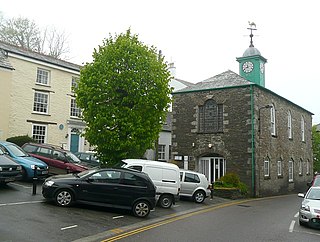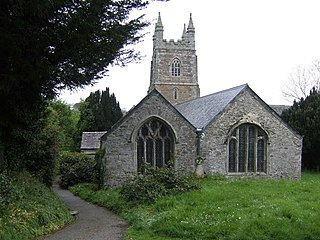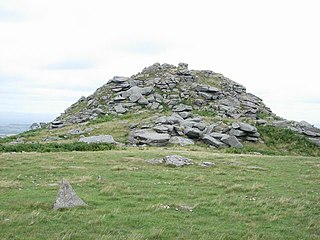The Antiqua maneria (ancient manors), also known as assessionable manors, were the original 17 manors belonging to the Earldom of Cornwall.
After March 1337, these manors were transferred to the new Duchy of Cornwall created by King Edward III to provide financial support to his son Edward, the Black Prince (1330–1376). These manors were referred to as assessionable manors because they were leased under assession leases, which were renewed periodically. [1]
The table below shows the 17 Antiqua maneria, including the number and status of Customary tenants in the early fourteenth century. The manors vary greatly in both size and importance. The parishes listed are the modern parishes, rather than those that existed in the 14th century. [2]
Conventionarii = Conventionary tenants; Villani = Villeins; Nativi = Villeins; Liberi Conventionarii = Free tenants; Nativi Conventionarii = Conventionary tenants; Nativi de Stipite = Villeins by descent
| Manor | 1300 | 1327-32 | 1333-1340 | ||||
|---|---|---|---|---|---|---|---|
| Conventionarii | Villani | Conventionarii | Nativi | Liberi Conventionarii | Nativi Conventionarii | Nativi de Stipite | |
| Calstock of Harewood House | 14 | 53 | – | – | 29 | 49 | 8 |
| Climsland | 23 | 81 | 25 | 69 | 28 | 49 | 18 |
| Helston in Kirrier | 76 | 11 | 102 | 6 | 102 | 5 | 2 |
| Helston in Trigg (Helstone in Lanteglos); and Penmayne | 33 | 78 | – | – | 37 | 72 | 11 |
| Liskeard | 41 | 26 | 46 | 36 | 49 | 34 | 4 |
| Moresk in St Clement parish | 20 | 19 | – | – | 24 | 20 | 2 |
| Penkneth in Lanlivery parish | 9 | 6 | – | – | 7 | 3 | 7 |
| Penlyne in Lostwithiel parish | 22 | 2 | – | – | 20 | 1 | 1 |
| Penmayne in St Minver parish | see | Helston in Trigg | – | – | – | – | – |
| Restormel in Lostwithiel parish | 2 | 12 | – | 15 | – | 8 | 8 |
| Rillaton in Linkinhorne parish | 7 | 6 | - | – | 3 | 10 | 5 |
| Talskiddy in St Columb Major parish | 2 | 1 | 4 | 3 | 3 | 3 | 0 |
| Tewington in Treverbyn parish | 43 | 11 | 52 | 12 | 52 | 6 | 5 |
| Tintagel (formerly Bossiney) | 14 | 28 | 25 | 30 | 26 | 30 | – |
| Trematon in St Stephens by Saltash parish | 29 | 21 | 38 | 25 | 37 | 16 | 6 |
| Tybesta, in Creed parish | 28 | 21 | 37 | 16 | 36 | 14 | 4 |
| Tywarnhaile in St Agnes parish | 12 | 15 | – | – | 11 | 15 | 2 |

Manorialism, also known as seigneurialism, the manor system or manorial system, was the method of land ownership in parts of Europe, notably France and later England, during the Middle Ages. Its defining features included a large, sometimes fortified manor house in which the lord of the manor and his dependants lived and administered a rural estate, and a population of labourers or serfs who worked the surrounding land to support themselves and the lord. These labourers fulfilled their obligations with labour time or in-kind produce at first, and later by cash payment as commercial activity increased. Manorialism was part of the feudal system.

Camelford is a town and civil parish in north Cornwall, England, United Kingdom, situated in the River Camel valley northwest of Bodmin Moor. The town is approximately ten miles (16 km) north of Bodmin and is governed by Camelford Town Council. Lanteglos-by-Camelford is the ecclesiastical parish in which the town is situated. The ward population at the 2011 Census was 4,001. The town population at the same census was 865.

The Duchy of Cornwall is one of two royal duchies in England, the other being the Duchy of Lancaster. The eldest son of the reigning British monarch obtains possession of the duchy and the title of Duke of Cornwall at birth or when his parent succeeds to the throne, but may not sell assets for personal benefit and has limited rights and income while a minor.
The title of Earl of Cornwall was created several times in the Peerage of England before 1337, when it was superseded by the title Duke of Cornwall, which became attached to heirs-apparent to the throne.

Creed is a village and former civil parish, now in the parish of Grampound with Creed, in the Cornwall district, in mid Cornwall, England. It is roughly midway between Truro and St Austell, about two miles (3 km) east of Probus. In 1961 the parish had a population of 203. On 1 April 1983 the parish was abolished to form "Grampound with Creed", part also went to St. Mewan.

Restormel Castle lies by the River Fowey near Lostwithiel in Cornwall, England, UK. It is one of the four chief Norman castles of Cornwall, the others being Launceston, Tintagel and Trematon. The castle is notable for its perfectly circular design. Once a luxurious residence of the Earl of Cornwall, the castle was all but ruined by the 16th century. It was briefly reoccupied and fought over during the English Civil War, but was subsequently abandoned. It is now in the care of English Heritage and open to the public.

Calstock is a civil parish and a large village in south east Cornwall, England, United Kingdom, on the border with Devon. The village is situated on the River Tamar 6 miles (9.7 km) south west of Tavistock and 10 miles (16 km) north of Plymouth.

Talskiddy is a small rural village about two miles north of St Columb Major in Cornwall, England, United Kingdom. Originally a manorial settlement belonging to the Earldom of Cornwall, the place prospered in the 19th century as a centre of the wool-combing industry.

Lanlivery is a village and civil parish in Cornwall, England, United Kingdom. The village is about 1+1⁄2 miles (2.4 km) west of Lostwithiel and five miles (8 km) south of Bodmin. The Saints' Way runs past Lanlivery. Helman Tor, Red Moor and Breney Common nature reserves lie within the parish.

Treverbyn is a civil parish and village in mid-Cornwall, England, United Kingdom, lying north of St Austell.

Stoke Climsland is a village in the valley of the River Tamar, Cornwall, England, United Kingdom within the civil parish of Stokeclimsland. The population of the parish including Luckett at the 2011 census was 1,703. An electoral ward of the same name also exists. At the same census the population was 3,703.

Cardinham is a civil parish and a village in mid Cornwall, England. The village is approximately three-and-a-half miles (6 km) east-northeast of Bodmin. The hamlets of Fletchersbridge, Millpool, Milltown, Mount, Old Cardinham Castle and Welltown are in the parish.

Linkinhorne is a civil parish and village in southeast Cornwall, England, United Kingdom. The village itself is situated at grid reference SX 320 736 and is approximately four miles (6.5 km) northwest of Callington and seven miles (11 km) south of Launceston. The parish population at the 2011 census including Downgate was 1,541

A villein is a class of serf tied to the land under the feudal system. As part of the contract with the lord of the manor, they were expected to spend some of their time working on the lord's fields in return for land. Villeins existed under a number of legal restrictions that differentiated them from freemen, and could not leave without his lord's permission. Generally, villeins held their status not by birth but by the land they held, and it was also possible for them to gain manumission from their lords. The villeinage system largely died out in England in 1500, with some forms of villeinage being in use in France until 1789.

Trevalga is a coastal civil parish and hamlet in north Cornwall, England, United Kingdom. The parish is bounded on the north by the Celtic Sea, on the southeast by Forrabury and Minster parish and on the west by Tintagel parish.

St Mellion is a village and rural civil parish in east Cornwall, England, United Kingdom. The parish is about 3 miles (5 km) south of Callington and is in the St Germans Registration District. To the north, the parish is bordered by Callington and St Dominick parishes, to the east and south by Pillaton parish, and to the west by St Ive parish.

Helstone is a hamlet in north Cornwall, England, United Kingdom. It is situated two miles (3 km) southwest of Camelford on the A39 road.
Penmayne is a hamlet next to Splatt in the civil parish of St Minver Lowlands in north Cornwall, England, UK.

Rillaton is a hamlet in the parish of Linkinhorne in Cornwall, England. Nearby is the Bronze Age round barrow where the Rillaton Gold Cup was found in 1837.

Harewood House was an ancient manor house, built originally by the Saxons, in Cornwall, England. Harewood Estate is surrounded by old mine workings, so the house faces towards Morwellham Quay.